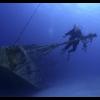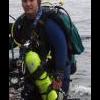Edited by drbill, 10 August 2006 - 10:56 PM.

Less than 21% O2
#16

Posted 10 August 2006 - 10:55 PM
#17

Posted 10 August 2006 - 11:47 PM
Good information presented in this thread. It illustrates the reason I do not dive Nitrox as a primary gas. I have done air several times to depths of 180-200 ft. Fortunately narcosis has never been a significant issue for me. I've looked into diving mixes in the 17-18% range for added safety at depth, but haven't tried them yet. I'm generally just down at max depth long enough to recon for certain species and only stay down for any "length" if video opportunities present themselves. Twice in the last week I've encountered shortspined combfish in the 180' range and stayed long enough to get decent video of them.
We have the Longspined Combfish up here although they aren't that common in my experience. I usually see them below 100 fsw and on silty terrain where there isn't much else to look at.
Do you have a still picture or link somewhere to the Shortspined version. Do they look similiar to the Longspined Combfish?
#18

Posted 11 August 2006 - 12:26 AM
Good information presented in this thread. It illustrates the reason I do not dive Nitrox as a primary gas. I have done air several times to depths of 180-200 ft. Fortunately narcosis has never been a significant issue for me. I've looked into diving mixes in the 17-18% range for added safety at depth, but haven't tried them yet. I'm generally just down at max depth long enough to recon for certain species and only stay down for any "length" if video opportunities present themselves. Twice in the last week I've encountered shortspined combfish in the 180' range and stayed long enough to get decent video of them.
We have the Longspined Combfish up here although they aren't that common in my experience. I usually see them below 100 fsw and on silty terrain where there isn't much else to look at.
Do you have a still picture or link somewhere to the Shortspined version. Do they look similiar to the Longspined Combfish?
Will be writing one of my future columns on it. It will be posted on my web site with a picture.
I've never seen the longspined combfish, and hadn't seen the shortspined one until last weekend.
#19

Posted 11 August 2006 - 01:50 AM
Good information presented in this thread. It illustrates the reason I do not dive Nitrox as a primary gas. I have done air several times to depths of 180-200 ft. Fortunately narcosis has never been a significant issue for me. I've looked into diving mixes in the 17-18% range for added safety at depth, but haven't tried them yet. I'm generally just down at max depth long enough to recon for certain species and only stay down for any "length" if video opportunities present themselves. Twice in the last week I've encountered shortspined combfish in the 180' range and stayed long enough to get decent video of them.
We have the Longspined Combfish up here although they aren't that common in my experience. I usually see them below 100 fsw and on silty terrain where there isn't much else to look at.
Do you have a still picture or link somewhere to the Shortspined version. Do they look similiar to the Longspined Combfish?
Will be writing one of my future columns on it. It will be posted on my web site with a picture.
I've never seen the longspined combfish, and hadn't seen the shortspined one until last weekend.
I'll try to remember to check your site from time to time. I've attached one of my pics of a Longspined Combfish.

Edited by gcbryan, 11 August 2006 - 01:52 AM.
#20

Posted 11 August 2006 - 06:30 AM
Well, I've read through some deco stuff, and some deep diving stuff, and I think I have a BASIC grasp of partial pressures etc., but would someone help explain in clear terms why less than 21% O2 is needed for deeper diving?
I think a lot of people would be interested, and it would be great for me to have it explained by one of our resident gurus - plus we can start throwing around terms like "hypoxic nitrox" at HH and impress the crowds listening in to our diving discussions!!
If you want to skip all the math, the issue is that Oxygen, under sufficient pressure, will cause a Gran Mal seizure, which is generally fatal under water.
What all of the math does for you is allow you to calculate the appropriate mix for a given depth, or the depth you can handle with a given mix. For that one should take the appropriate mixed gas courses.
If you consider yourself to be math challenged, take these courses anyhow. Once you are through the course, the actual calculations are generally done on a computer, either a PC or a dive computer, but you do need to go through the math once to understand how the factors interact.
Edited by Geek, 11 August 2006 - 06:39 AM.
#21

Posted 11 August 2006 - 09:18 AM
#22

Posted 11 August 2006 - 09:21 AM
Curious about one question I think I know the answer for. At greater depths one usually encounters colder, denser water. Is this factored into the partial pressure calculations or do we just assume these differences are relatively minor? Probably answered in BOW, but that was nearly 40 years ago.
The density of the water at 200ft is not significantly different (for breathing gas purposes) so no factoring is necessary.
I've seen plans for dives to 600+ ft, and no factoring was done.
#23

Posted 11 August 2006 - 11:19 AM
What does the 17/40 mean?
#24

Posted 11 August 2006 - 11:23 AM
1 user(s) are reading this topic
0 members, 1 guests, 0 anonymous users















